Savor the Authentic Flavors of Japanese Pub Culture
Imagine a Japanese businessman stopping by an “izakaya” (Japanese pub) after a long day at work.
These casual spots offer a comforting atmosphere and a delicious array of food and drinks perfect for unwinding and chatting with colleagues.
Surprisingly, many regulars have around four or five favorite izakayas they frequent.
While they often order familiar dishes, the subtle differences in flavor from one establishment to another keep things interesting.
For those who haven’t experienced an izakaya yet, here are 10 classic dishes you absolutely should try, with descriptions to help you imagine their appeal.
Table of Contents
Dashimaki Tamago – Savory Dashi Rolled Omelet Infused with Umami Broth

Dashimaki Tamago is a rolled omelet characterized by its fluffy texture and the rich aroma of “dashi,” a fundamental Japanese broth.
When you cut into it, you can see many thin layers of egg stacked together.
The outside has a light golden-brown hue, while the inside is a vibrant yellow, appearing moist and tender.
The star of this dish is undoubtedly the dashi.
Typically, “ichiban dashi” (first-draw dashi), carefully extracted from kombu (kelp) and katsuobushi (dried bonito flakes), is used. Its rich flavor enhances the natural sweetness of the eggs.
With each bite, a gentle dashi fragrance fills your mouth, followed by the sweetness of the egg and subtle notes of soy sauce and mirin (sweet rice wine).
The texture is incredibly smooth, almost silky, melting in your mouth.
Dashimaki Tamago is a staple on izakaya menus, enjoyed as an appetizer or a palate cleanser during a meal.
It’s often served in bite-sized pieces, with grated daikon radish and soy sauce on the side for those who wish to add them.
This seemingly simple dish has a surprising depth.
The flavor can vary significantly depending on the type of dashi and the blend of seasonings used.
For example, the Kansai (western Japan) style uses kombu-based dashi and light soy sauce, resulting in a mellow and elegant taste.
In contrast, the Kanto (eastern Japan) style often uses katsuobushi-based dashi and dark soy sauce, giving it a richer and cleaner flavor.
This regional and restaurant-specific variation is part of the dish’s charm.
Achieving the perfect fluffy texture requires a precise ratio of eggs to dashi and careful cooking.
A dashimaki tamago prepared by a skilled chef is truly a work of art.
Recently, some izakayas offer creative variations with fillings like spicy cod roe mayonnaise, green onions, or tuna, adding to its appeal.
Tori no Karaage – Irresistibly Fragrant and Juicy Japanese Fried Chicken

Tori no Karaage is a hugely popular Japanese fried chicken dish and a standard on izakaya menus.
Bite-sized pieces of chicken are marinated and then deep-fried in a crispy coating, resulting in a fragrant aroma and juicy texture that’s simply addictive.
Chicken thigh meat is typically used, and when fried, it turns a tempting golden brown.
The first bite offers a satisfying crunch from the coating, followed by a burst of hot, flavorful juices and the natural umami of the chicken.
A crucial element in delicious karaage is the marinade.
A base of soy sauce, ginger, and garlic, often with added sake (rice wine) and mirin, infuses the chicken with a deep flavor.
Some establishments use their own secret blend of spices and seasonings, creating a unique taste.
Thoroughly massaging the marinade into the chicken is said to enhance its flavor even further.
The coating also significantly impacts the texture.
While potato starch and wheat flour are commonly used, the specific combination and type vary by restaurant.
Potato starch tends to create a crispier texture, while wheat flour results in a lighter finish that stays tasty even when cooled.
Combining both can offer the best of both worlds.
The frying technique is also important; some places double-fry the chicken for extra crispiness.
Precise oil temperature control ensures the outside is crunchy and the inside remains juicy.
In izakayas, karaage is often served with a wedge of lemon. Squeezing the lemon juice over the hot, freshly fried chicken provides a refreshing contrast. It’s also delicious with mayonnaise or other condiments according to your preference.
Kushikatsu Moriawase – Hot and Crispy Skewered Cutlets, a Specialty of Osaka
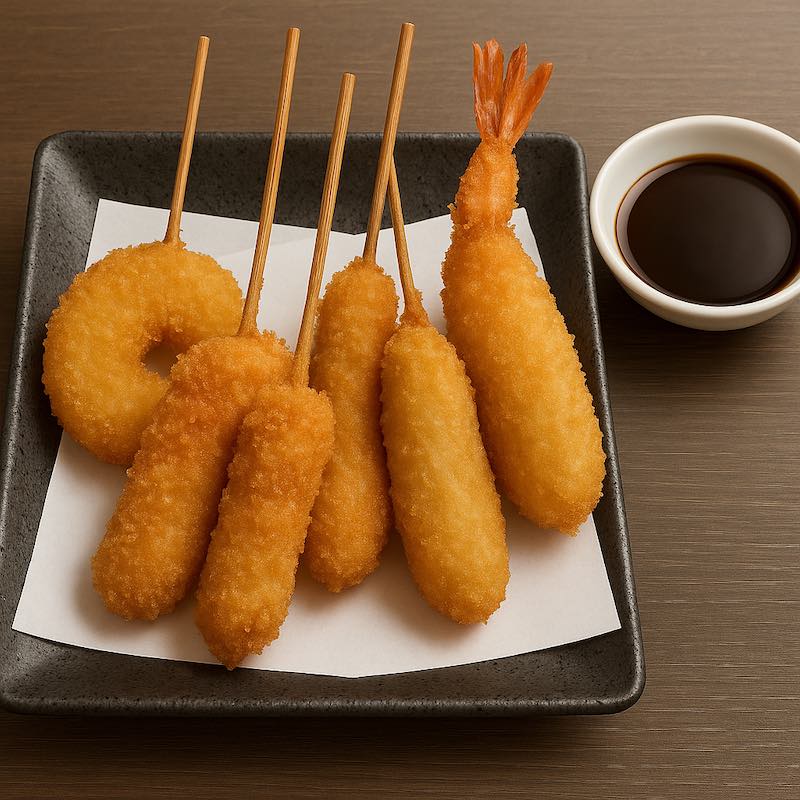
Kushikatsu is a B-grade gourmet dish originating in Osaka, where various ingredients like meat and vegetables are skewered, coated in breadcrumbs, and deep-fried.
In izakayas, a “Kushikatsu Moriawase” (assorted skewered cutlets) is a popular choice.
The assortment varies from restaurant to restaurant but typically includes beef, pork, shrimp, squid, onion, eggplant, and lotus root, offering a delightful variety of flavors and textures.
These freshly fried, piping hot skewers have a wonderfully crispy exterior that seals in the savory juices of the ingredients inside.
The real treat of kushikatsu lies in its texture and the unique dipping sauces offered by each establishment.
These sauces can range from sweet to spicy to fruity, each designed to complement the different types of kushikatsu.
Be aware of the common rule in many kushikatsu restaurants: “No double-dipping!”
Yakitori Moriawase – Savor the Fragrant Charcoal-Grilled Chicken Skewers
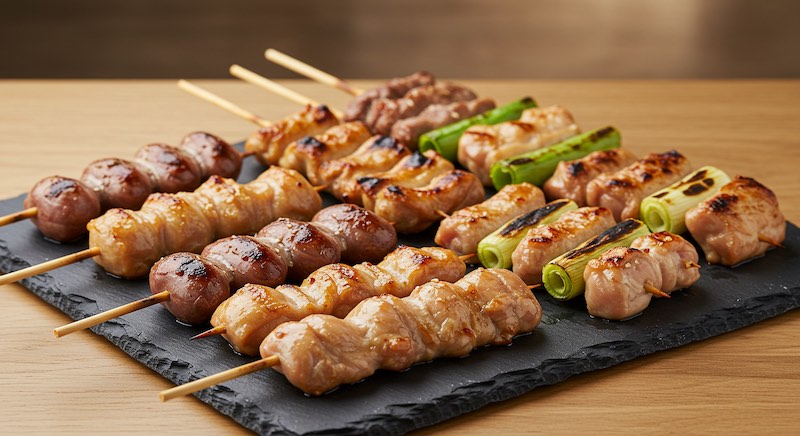
Yakitori is a quintessential Japanese dish where chicken pieces are skewered and carefully grilled over charcoal.
An “Yakitori Moriawase” (assorted grilled chicken skewers) is a standard offering at izakayas, allowing you to sample a variety of chicken parts.
You can enjoy different textures and flavors from parts like thigh (momo), chicken and scallion (negima), breast (mune), neck (seseri), skin (kawa), minced chicken meatballs (tsukune), heart (hatsu), and gizzard (sunagimo).
Grilling over charcoal intensifies the chicken’s umami and imparts a smoky aroma that stimulates the appetite.
The two main types of seasoning are a sweet and savory soy sauce-based sauce (tare) and salt (shio).
Tare-grilled yakitori has a rich flavor that pairs perfectly with rice and sake.
Salt-grilled yakitori allows the natural flavor of the chicken to shine through.
Otsukemono – Pickled Vegetables, a Traditional Japanese Accent to Your Meal
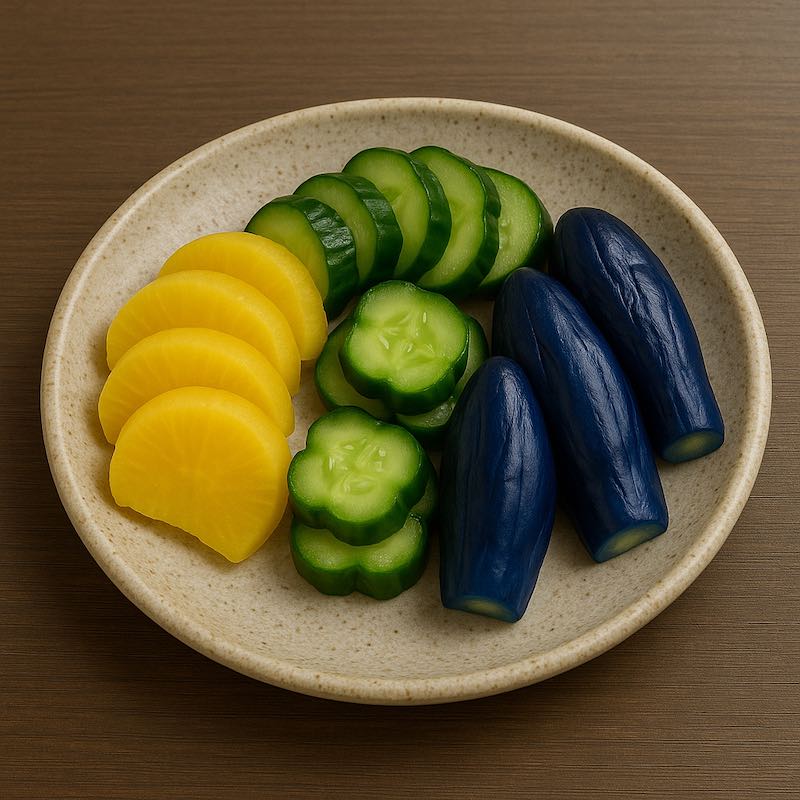
Otsukemono are traditional Japanese pickles made by (tsukekomu – pickling) vegetables in salt, rice bran, soy sauce, miso, and other ingredients. Izakayas offer various types of otsukemono served in small dishes, enjoyed as palate cleansers or as accompaniments to drinks.
With a wide variety including hakusai-zuke (pickled napa cabbage), kyuri no asazuke (lightly pickled cucumber), daikon no bettarazuke (sweet pickled daikon radish), shibazuke (pickled cucumber and eggplant), and narazuke (pickled melon in sake lees), you can experience a range of flavors and textures.
Their refreshing taste is a perfect counterpoint to richer dishes.
Saba no Kizushi – Marinated Mackerel, a Refined Delicacy Often Enjoyed as a Finishing Touch
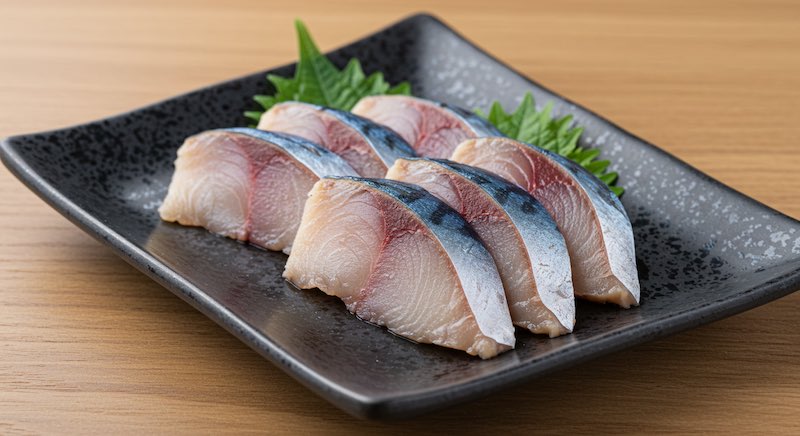
Saba no Kizushi is a dish made by filleting fresh mackerel and lightly curing it with salt and vinegar.
It’s particularly popular in the Kansai region and a common item on izakaya menus.
The fish has a moist texture, and each bite releases the rich flavor of the mackerel balanced by the refreshing tang of vinegar.
There’s no fishy taste, just a refined and elegant flavor.
Thinly sliced, it’s also visually appealing and pairs wonderfully with Japanese sake.
Tempura Moriawase – Light and Crispy Deep-Fried Delights that Highlight the Ingredients’ Natural Flavors
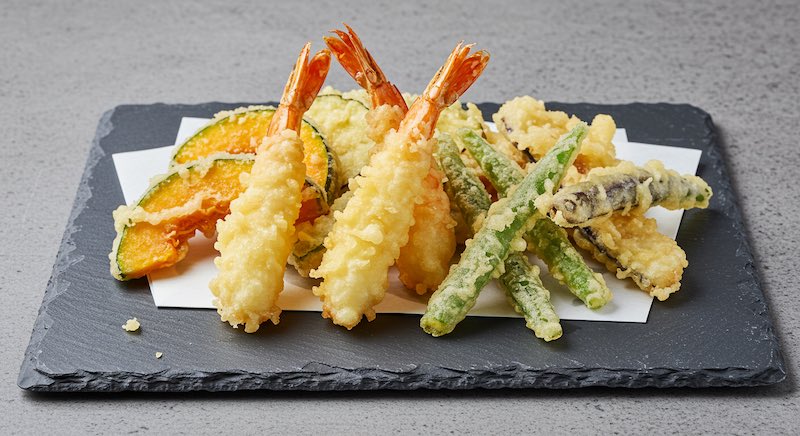
Tempura is a Japanese dish where seafood and vegetables are lightly battered and deep-fried.
A “Tempura Moriawase” (assorted tempura) is a popular choice in izakayas, allowing you to enjoy a variety of tempura in one serving.
You’ll typically find seafood like shrimp (ebi), sillago (kisu), and squid (ika), along with colorful vegetables such as eggplant (nasu), pumpkin (kabocha), green bell pepper (piiman), and shishito peppers.
Freshly fried tempura has a light and crispy coating, allowing you to fully appreciate the natural taste and aroma of the ingredients.
It’s commonly served with “tentsuyu,” a dashi-based dipping sauce with grated daikon radish and ginger.
Eating it with just salt is also recommended to savor the pure flavor of the ingredients.
Tomato Slices – A Surprisingly Popular Simple Classic
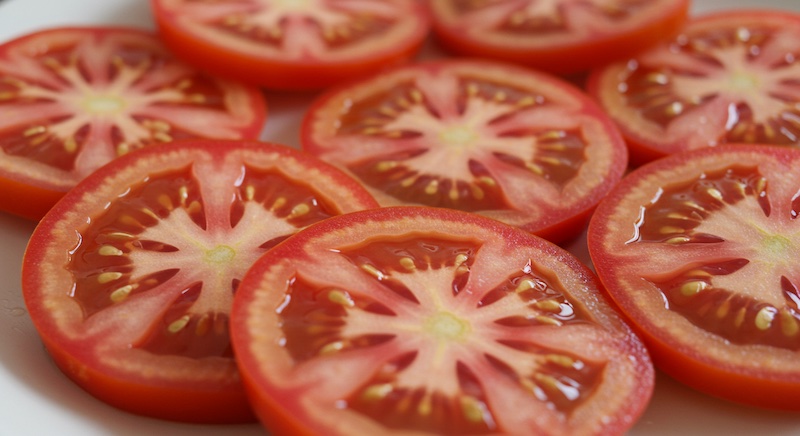
Tomato slices might seem like a very simple dish on an izakaya menu, but they are surprisingly popular.
Just fresh tomatoes, sliced, their refreshing juiciness and natural sweetness provide a welcome break for the palate.
Especially in izakayas where richer dishes are common, tomato slices are an excellent palate cleanser.
They are often served with mayonnaise or salt, allowing you to adjust the flavor to your liking.
Edamame – An Essential Side for Your First Drink
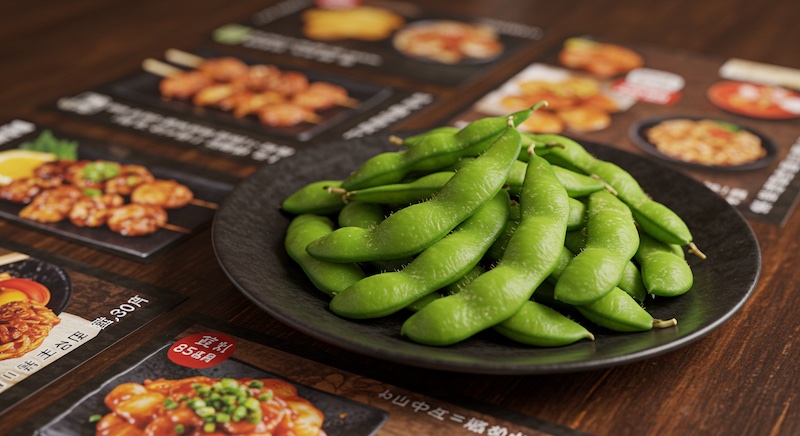
Edamame are young soybeans boiled in their pods with a light seasoning of salt.
They are an absolute staple in izakayas as an accompaniment to your first drink.
The subtle salty flavor pairs perfectly with beer.
Whether served warm or chilled, freshly boiled edamame are always a treat.
While extracting the beans from the pods can be a little hands-on, it’s part of the unique izakaya experience.
Hiyayakko – Simple is Best, the Pure Taste of Cold Tofu
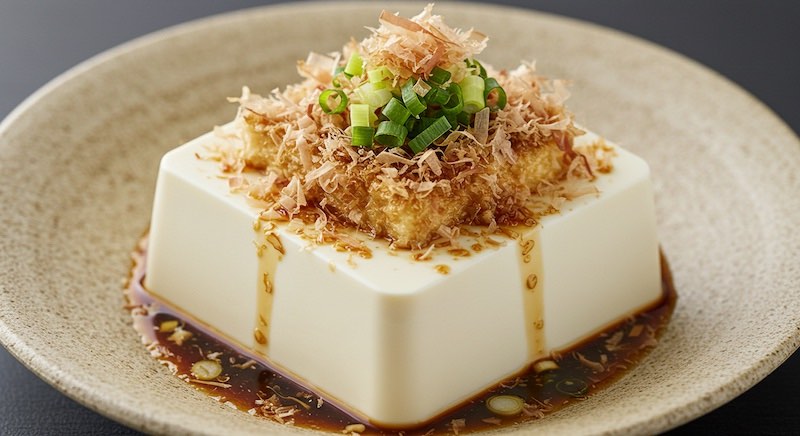
Hiyayakko is a simple yet profoundly flavorful dish of cold tofu topped with various condiments.
Silken or firm tofu is used, offering a smooth texture and the delicate, natural taste of soybeans.
For more information about tofu, click here: Rediscover the Magic of Tofu!
Common toppings include green onions (negi), grated ginger (shoga), bonito flakes (katsuobushi), and Japanese ginger (myoga), all drizzled with soy sauce.
Despite its simplicity, it’s a dish that highlights the quality of the ingredients and pairs well with various types of alcohol, including sake and shochu (Japanese distilled spirits).
Conclusion
Beyond these 10 classic dishes, Japanese izakayas offer a wealth of other appealing options. Each establishment brings its own unique touch to its cuisine, making it fascinating how even the same dish can taste different from one place to another. We encourage you to explore various izakayas and discover your own favorite dishes. We hope this information enhances your izakaya experience!
For more information about izakayas, please visit the Izakaya Association website.

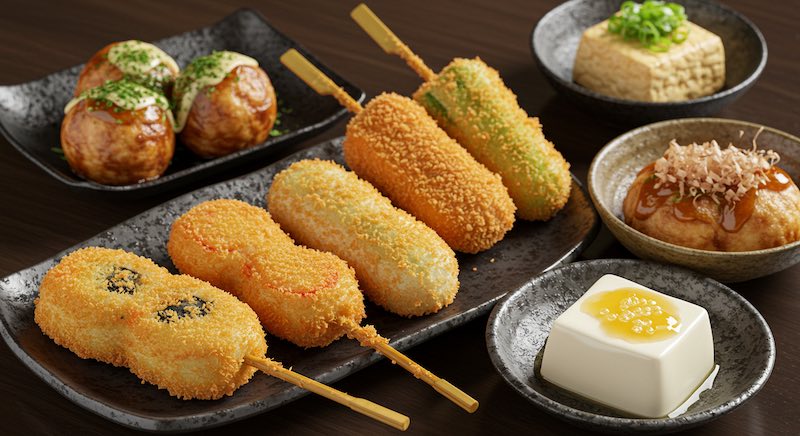







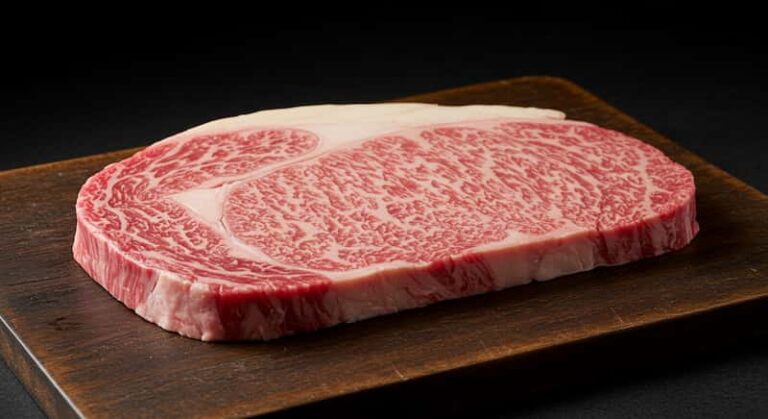




Leave a Reply